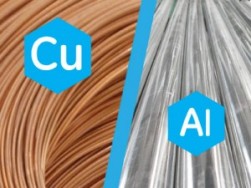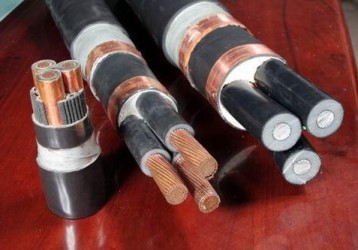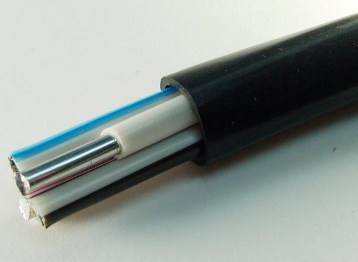Categories: Featured Articles » Controversial issues
Number of views: 34821
Comments on the article: 16
Copper or aluminum - which is more profitable?
 Only two metals - copper and aluminum are widely used as conductors of electric current. Their use as such is determined by the complex physical properties of the metals themselves and their price.
Only two metals - copper and aluminum are widely used as conductors of electric current. Their use as such is determined by the complex physical properties of the metals themselves and their price.
Physical fundamentals of the flow of electric current in conductors
As is known from physics, an electric current is an ordered movement of electric charges in a conductor, under the influence of electric field forces. When moving electric charges in a conductor, they undergo a counteraction, which is estimated by the value of electrical resistance and which is measured in ohms (Ohms).
The electrical resistance for cylindrical conductors is determined by the formula r =ρ* l / s, where r - electrical resistance of a conductor, Ohm, ρ - electrical resistivity of the conductor material, Ohm * mm2 / m, l - conductor length, m, s - conductor cross-sectional area, mm2
Therefore, in electrical engineering, materials with low resistivity (copper, aluminum, steel) are used for the manufacture of wires.
For example: Copper resistivity - 0,0175 ohm * mm2/ m, the resistivity of aluminum is 0, 0294 ohm * mm2/ m
Sometimes instead of electrical resistance r, an inverse value is used - conductivity g = 1 / r, and instead of specific resistance - specific conductivity γ = 1 /ρ. Electrical conductivity is measured in Siemens (cm).
When moving electric charges in a conductor, electrical resistance causes the conductor to heat up. This heating is harmful and, when operating the conductor, should be limited, taking into account the physical properties of the conductor and the insulation class.
The steady-state temperature of the conductor with current depends on the current density, which is determined by the formula: δ = I / s, where δ is the current density, and / mm2, I is the current value, and s is the cross-sectional area of the conductor, mm2

What is more profitable to use as electrical wires - copper or aluminum?
When comparing the growth trends in the cost of aluminum and copper during the twentieth and the beginning of the twentiethI centuries, it is obvious that the cost of aluminum is growing more slowly than copper. This difference is especially visible at the beginning of the twentieth.I century. Since 2006, the cost of copper at the London Metal Exchange has reached $ 8,500 / ton, while aluminum — 2500 dollars / ton. This is due to the improvement and increase in aluminum production, with affordable and inexpensive raw materials for the production of cable products, which, in the cost of the final product, is 25%.
For copper - the situation is different. Copper ore reserves are deteriorating, the content of copper ore is falling, new deposits are poor in metal and more difficult to extract. In addition, these deposits are geographically more inaccessible. Therefore, the cost of raw materials in the cost of the final product is more than 50% and is still growing.
These trends do not change, as does the comparative dynamics of prices, but no changes are foreseen. All this speaks in favor of the use of aluminum.
Scientific discovery of superconductivity and its industrial application is still unattainable for world practice. In light of the fact that the electrical conductivity of aluminum is lower than that of copper, the cross section of the aluminum wire and, consequently, its volume should be larger than that of copper, and the diameter of the aluminum wire, for the same current density, should be 25% larger than copper.
However, an increase in the volume, and hence the mass of the aluminum wire, is leveled out by a low metal density (2.7 t / m3 — aluminum, 8.9 t / m3 — copper). Therefore, the mass of aluminum wire, for the same current density, is three times less than copper.
However, there is no gain in mass when using aluminum wire instead of copper, due to the requirements of SNIP, no.For example, the mass of copper in the laid wires and cables in the panels of a modern three-room apartment is 10 kg. Weight of a three-core cable length of 1000 meters of VVG cable (copper) with a cross section of 1.5 mm2 is 93 kg, and the mass of the equivalent AVVG cable (aluminum) with a cross section of 2.5 mm2 is 101 kg. The benefits of using aluminum wires are due to much lower aluminum prices.
At today's prices, the use of aluminum wires is several times more profitable than copper!
For high-voltage lines and for overhead cable systems, aluminum has been used for a long time. But in insulated wires, increasing the diameter of the core requires an increase in the consumption of cable PVC plastic compound, the price of which ($ 1800 / ton) is close to the price of aluminum. The thinner the wires, the greater the comparative cost of electrical insulation, and the benefits of switching from copper to aluminum are lower. However, at current prices, the savings are still significant!
Designers, architects, electricians must overcome the bias against the use of aluminum wires in new construction. This will allow the use of cost-effective, but labor-intensive aluminum for wiring in panels and in leads to external load points (sockets and switches), which will result in significant savings.
Aluminum winding wires can, with noticeable benefits, be used in the production of low-power transformers, electric motors and other electrical machines.
All this will determine the huge demand for aluminum in the world market and the use of “winged metal” on the ground.
What do you think about this? Leave your comment on the article!
See also at bgv.electricianexp.com
:

